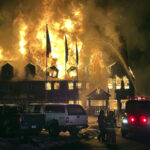Nobody likes to lose their shirt, least of all insurers. So it’s no surprise that, following the huge losses caused by natural disasters in the past few years, insurers have bolted from the homeowners market, leaving behind a lack of coverage for residents in many parts of the U.S.
Now the problem, as Robert Rusbuldt, executive vice president of the Independent Insurance Agents of America (IIAA), described it, is that “our agents do not have a product to sell.” The Big “I” and other industry groups believe the solution to this problem could lie in the form of legislation called the Homeowners Insurance Availability Act of 2000 (HR 21).
By definition, the Homeowners Insurance Availability Act directs the Secretary of the Treasury to make reinsurance coverage available for purchase by eligible state programs, as well as by private insurers and reinsurers, state insurance and reinsurance programs, and other interested entities through auctions. The program would be designed “for the purpose of facilitating the pooling and spreading the risk of catastrophic financial losses from natural disasters, and to improve the solvency of homeowners’ insurance markets.”
The bill is a combination of two proposals originally offered last year by House Banking Committee Housing Subcommittee Chairman Rick Lazio (R-N.Y.) and by panel Vice Chairman Bill McCollum (R-Fla.).
HR 21 was approved by the Banking Committee by a 34-18 bipartisan vote in November 1999, and is now waiting to get to the floor of the House, according to Jack Weber, president of the Virginia-based Home Insurance Federation of America and a leading expert on natural disasters.
“We are closer than we have ever been to enacting natural disaster reform,” Weber said. “We’ve seen tremendous contraction in homeowners markets that have exposure, particularly to hurricane…The willingness of insurance companies to write in highly populated coastal areas has really shrunk dramatically, as evidenced by growth in FAIR plans and wind-pools and that sort of thing. One of the things that we would expect to happen with the availability of federal reinsurance is some stability returning to those markets.”
State by state
Thus far, three states-California, Florida and Hawaii-have created programs to improve the situation. California’s program, the California Earthquake Authority (CEA), has a $10-billion maximum capacity, but this capacity could potentially be exceeded by even one catastrophe.
Weber stressed that “it’s not just California, Florida and Hawaii, it’s nationwide.” Other key areas of concern include New York, New Jersey, the Carolinas and Texas.
“The wind-pools in North Carolina have been growing at astronomical rates in the last few years, kind of in tandem with the increased frequency of hurricanes on the Carolina coast,” Weber said. “Our understanding is that it is extremely difficult to find coverage from an insurance company directly anywhere within 100 miles of the North Carolina coast.”
Weber said the wind-pool or the FAIR plan in Louisiana-which is “the market of last resort”-is up almost 900 percent this decade.
Exposures are not confined to a state-by-state basis, according to Jeff Myers, IIAA vice president-public affairs. “Earthquake exposure extends into all states to some degree or another,” Myers said. “There is technically even hurricane exposure on the West Coast, although when is the last time you heard of a hurricane hitting California?”
Running for safety
Hurricane Andrew and the Northridge earthquake were two recent multi-billion dollar catastrophes that illustrated how easily insurance companies could go insolvent with too much risk concentrated in disaster-prone areas. Faced with these statistics, many major carriers-such as GEICO, CNA and Aetna-have been looking for ways to non-renew or stop writing homeowners policies rather than play the game.
“GEICO has pulled out of the market entirely…they sold that division simply because they weren’t willing to accept the exposure,” Weber said. “CNA has also been pulling out, so have most carriers. In fact, I would challenge anyone to come up with evidence that people are writing more business in these markets.”
However, as with any legislation, there is opposition.
“There are opponents of the bill that don’t like the thought that the federal government is going to be involved at all in anything,” Weber said. “To those people our answer is: ‘there are certain things that, frankly, there is nobody but the federal government that can play an active role.’ The notion that the private market is simply going to absorb $40-60 billion of hurricane exposure is just not valid.
“The market has already indicated through their actions that they are not willing to absorb an infinite amount of exposure, and what we have occurring is that a larger and larger percentage of the population is moving into areas where insurance companies are concerned that the potential exposure is such that it could break their own financial wherewithal.”
Facing a turning point
One thing is certain: the status quo will not continue.
“Something’s got to give,” Weber concluded. “Either we are going to go to a system where we no longer have homeowners insurance coverage against the perils in these areas, or we’re going to allow some kind of a system to manage those worst case exposures which hopefully will make it easier for insurance companies to continue to stay in these markets.”
Topics Catastrophe Natural Disasters California Carriers Legislation Reinsurance Hurricane Homeowners
Was this article valuable?
Here are more articles you may enjoy.


 Owner of Historic Minnesota Resort Charged With Arson, Insurance Fraud
Owner of Historic Minnesota Resort Charged With Arson, Insurance Fraud  Acrisure to Buy MGA Vave From Canopius
Acrisure to Buy MGA Vave From Canopius  Brookfield Targets Global Dominance in P/C Insurance Coverage
Brookfield Targets Global Dominance in P/C Insurance Coverage  Acrisure CEO Greg Williams Makes $400M Commitment to Michigan State University
Acrisure CEO Greg Williams Makes $400M Commitment to Michigan State University 


